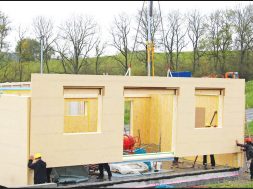Airports In India: Strengthening Footholds
With better policies and ambitions, airports sector is in better place than ever before to reach the zenith
“Achchhe din” for India is still in future tense; however, “achchhe din” for aviation industry seems to be a reality. According to the Airports Authority of India (AAI), passenger throughput increased to 159 million and cargo to 2.19 million tones in FY 2013. If the trends continue, India is going to be the third largest aviation market by 2020.
Present scenarioAccording to Airports Authority of India (AAI), passenger handling capacity has increased from 72 million (FY-06) to 220 million (FY-13-14). Although growth in passenger traffic in last fiscal was negative, but it has shown signs of recovery in the present fiscal. There is 6.4 per cent increase in passenger traffic from April 2013 to Feb 2014 over the corresponding period in FY 2012-13.
Currently, India has around 450 used, unused, or abandoned airports and airstrips. During the 11th Five-Year Plan (2007–2012), India witnessed the completion of four international airport projects through the public-private partnership (PPP). During that period, five Indian carriers also began to function on international routes. However, there is a huge space to fill. Many Tier-II and Tier-III cities are still unconnected.
Major developmentAAI has recently completed expansion and upgradation of two metro airports at Kolkata and Chennai Airports at the cost of ` 2,324 crore and ` 2,015 crore, respectively. Annual cargo handling capacity and efficiency of operations at Chennai Airport has been augmented to handle 11 lakh MT of cargo with the construction of new modern Import Cargo Complex equipped with Automatic Storage Retrieval System at a cost of ` 144 crore.
Development of selected 35 non-metro airports has been undertaken by AAI which are identified based on the regional connectivity, development of regional hubs, places of major tourist attraction and potential for development as business hubs.
In order to improve the standard of airports infrastructure, the Ministry of Civil Aviation has decided to pursue several strategies. • The ministry has decided to ensure better connectivity for hitherto un-served and underserved areas of the country specially the North-Eastern (NE) regions of the country, Jammu and Kashmir and the Islands of Lakshadweep, Andaman and Nicobar. For this, airports and airstrips that provide landing facilities to ATRs and smaller aircrafts would be developed across these regions. • Seaplanes would be introduced in the islands and coastal areas to improve inter-island connectivity. • The airports in NE would be resuscitated and upgraded to facilitate greater connectivity. • States would be encouraged to introduce subsidies on the pattern of Manipur and Madhya Pradesh to improve passenger load factor which would make operations on these routes commercially viable. • Mechanisms would be developed for seamless dovetailing of SOPs and NSOPs among major airports and centres of lower passengerload/infrastructure so that the hub and principle of connectivity can be actually realised.
Foreign direct investmentThe foreign direct investment (FDI) in airports sector is a huge boost for India. The government has approved 100 per cent FDI on automatic route for Greenfield airports. For existing airports, up to 74 percent FDI automatic route is permitted.
All the investments would be under government approval route, complying with all applicable rules and regulations including that of SEBI. It will require clearance from Home Ministry and FIPB.
Improved airport infrastructure In India, airports are generally developed under three models. These are (1) by AAI, (2) by Central Government/ State Government/ NEC, or (3) by Public-Private Partnership (PPP). Whatever the mode, from now on, development of airports would be guided by a set of principles. These are described below:• District level airport with population less than 2 lakh should have the facility to cater for aircraft having seating capacity of 30 seats. • Tourist or pilgrimage centres should have the facility to cater for aircraft having seating capacity 30 to 80 seats. • State capital airport should have the facility to cater for aircraft having seating capacity 80 to 200 passengers.• Commercial centres or towns should have the facility to cater for aircraft having seating capacity 200 to 250 passengers.• Non-metro international airports should have the facility to cater for aircraft having seating capacity 250 and above.• Special requirement of air connectivity to NE region, J&K, A&N islands, Lakshadweep islands as socio-economic commitment. • All non-operational AAI or state government airports and all Greenfield airports can be developed through PPP model and BOOT scheme.
What keeps the industry grounded?Development of airport infrastructure requires addressing several challenges. Some of the key issues are highlighted below: Addressing the challenges• Corporatisation of AAI: Given the increasing complexity of the AAI’s role and the need to enhance organisational capabilities, create flexible decision making, enhance financial viability and thereby respond more efficaciously to emerging market challenges, it is desirable that AAI move towards a corporate structure in the near future. • Develop alternate funding options: This may include different combinations of equity, soft loans and grants.• Assess the feasibility of developing low cost airports: By reducing the capital cost and ongoing operating costs, one can improve the IRR of airport investments.• Involvement of local administration in airport master plans: This will help identify land related issues at early stages and enable solutions to be developed.• City-side airport development: This helps address the issue of land availability within the city.• Ensure that airports have the option to expand: New airports should be planned in such a way that there is an opportunity to expand in the future; preventing land issues from re-surfacing when further infrastructure is required.
Going GreenIn the recent past, AAI has taken up several initiatives towards sustainable development like:• Use of all electrical appliances conforming to Bureau of Energy Efficiency (BEE) with rating 4-Star and above • Occupancy sensors, timers to shut off lights automatically • Building Management System (BMS) being implemented in new projects, where in new terminals have been constructed / under progress. This will help to make optimum use of energy to meet functional requirement/energy demand • Energy efficient chillers and variable speed drives are being used to improve mechanical efficiency of air-conditioning plants, air handling units, pumps etc. • Energy efficient fluorescent lamps (T5) are being used. For indoor lighting use of LED lamps, which is more energy efficient and has longer life, is proposed for new projects • Automatic sliding doors and air curtains are being used to reduce air- conditioning loss • Machine room less elevators are used at airports which conserve approximately 40 per cent energy as compared to conventional elevators • Escalators are provided at airports with sensors to save energy • Replacement of taxi way and apron edge lights with LED lights at Indore, Guwahati and Jaipur airports • Baggage conveyor system with sensor for baggage location and occupancy provided for automatic stopping of baggage system.
Way forwardContinuing the government’s high pitch for public private partnership (PPP), Finance Minister Arun Jaitley announced developing of new airports in smaller cities and towns under PPP.
India plans to build 200 low-cost airports in the next 20 years to connect tier-II and tier-III cities.
The government has finished development work at 33 non-metro airports for increasing regional connectivity and plans to build 15 more airports under the greenfield airport policy.
The aviation industry’s potential in India is massive. The market already caters to about 150 million passengers passing through its many airports, with the potential to grow further. The aviation industry presently supports about 0.5 per cent of the India’s GDP. As the aviation sector is likely to see investments totaling $12.1 billion during the 12th Plan, it is just waiting to reach higher ($1.5 billion by 2020).
If proposed Essential Air Services Fund (EASF) by the Ministry of Civil Aviation is established as quickly as possible, Indian airports would be the world’s envy. A successful implementation would drive higher growth of tourism, employment and local economic activities.
———Indira Gandhi International Airport (New Delhi)Operator: Delhi International Airport Private Ltd. (DIAL)Passenger movements: 36.8 millionAircraft movements: 290,772Cargo tonnage: 605,699———Chhatrapati Shivaji Airport (Mumbai)Operator: Mumbai International Airport Ltd. (MIAL)Passenger movements: 32 millionAircraft movements: 260,666Cargo tonnage: 648,742———Rajiv Gandhi International Airport (Hyderabad)Operator: GMR Hyderabad International Airport Ltd. (GHIAL)Passenger movements: 8.5 millionAircraft movements: 87,741Cargo tonnage: 86,670———Netaji Subhas Chandra Bose International Airport (Kolkata)Owner/Operator: Airports Authority of IndiaPassenger movements: 10 millionAircraft movements: 92,871Cargo tonnage: 129,782———Chennai International Airport (Chennai)Operator: Airports Authority of IndiaPassenger movements: 12.8 millionAircraft movements: 121,817Cargo tonnage: 292,080—————–Upcoming projectsNew civil enclaves: Bhatinda, Jaisalmer and Bikaner
Projects nearing completion (terminal building & allied works): Khajuraho and Kadappa
Projects in progress: Tirupati, Chandigarh (Mohali side), Pakyong (Sikkim- new Greenfield Airport), Tezu (Arunachal Pradesh), Vadodara, Hubli, Belgaum and Kishangarh.
Projects on the anvil (new terminals &aerodromes): Port Blair, Jammu, Guwahati, Itanagar (new greenfield airport), Deoghar (Jharkhand), Kishangarh (Rajasthan), Leh (J&K), Jharsuguda (Odisha), Vijaywada (AP), Raigarh (Chattisgarh), Pantnagar (Uttranchal), Solapur (Maharashtra) Meerut, Muradabad, Faizabad, Agra (New CE), Allahabad (new CE), and Kanpur (New CE) in UP. ———–
18
Cookie Consent
We use cookies to personalize your experience. By continuing to visit this website you agree to our Terms & Conditions, Privacy Policy and Cookie Policy.









